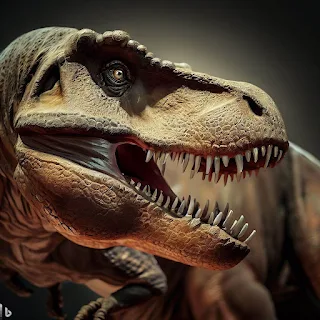Tyrannosaurus rex is one of the most famous and iconic dinosaurs of all time. Its name means “king of the tyrant lizards” and it was one of the largest and most powerful predators that ever lived. But how much do we really know about this fearsome creature? And was it truly the undisputed ruler of its domain? In this article, we will explore some of the latest research and discoveries that challenge some of the common assumptions and myths about T. rex.
How Fast Could T. rex Run?
One of the most debated questions about T. rex is how fast it could run. Some popular depictions of the dinosaur, such as in the Jurassic Park movies, show it chasing down cars and humans at speeds of up to 45 mph (72 km/h). However, many scientists doubt that T. rex was capable of such high speeds, and some even suggest that it could not run at all.
The main problem with estimating the speed of T. rex is that we do not have any direct evidence, such as fossilized footprints or trackways, that show how it moved. Instead, we have to rely on indirect methods, such as comparing its anatomy and physiology to living animals, or using computer models and simulations. These methods have their limitations and uncertainties, and often produce conflicting results.
One recent study, published in 2023 in the journal Science, used a biomechanical model to determine the minimum mass of leg muscles required for an animal to run. The researchers found that T. rex would need extremely large and powerful leg muscles to support its massive body weight and overcome the inertia of its long tail. However, such muscles would not fit within its relatively slender legs, and would also generate too much heat and require too much oxygen for the dinosaur to sustain a running gait. Therefore, the study concluded that T. rex could not run, and was limited to walking speeds of about 10 mph (16 km/h).
Another study, published in 2017 in the journal PeerJ2, used a different approach that combined two separate biomechanical techniques: multibody dynamic analysis and skeletal stress analysis. The former technique calculates the forces and torques acting on the bones and joints during locomotion, while the latter technique evaluates the risk of bone failure due to excessive stress. The study found that running gaits would likely cause unacceptably high skeletal loads in T. rex, especially in its lower leg bones. The study also suggested that T. rex had relatively long limb segments, which are usually associated with fast-running animals, but these were actually mechanically disadvantageous for running and were more likely adaptations for walking efficiency.
Both studies challenge the idea that T. rex was a high-speed pursuit predator, and instead support the notion that it was an ambush hunter or a scavenger that relied on its powerful bite and keen sense of smell to catch its prey.
Did T. rex Have Lips?
Another controversial question about T. rex is whether it had lips or not. Most popular depictions of the dinosaur show it with exposed teeth, similar to a crocodile’s mouth. However, some paleontologists have argued that T. rex had lips that covered its teeth, similar to a lizard’s mouth.
The main evidence for this hypothesis comes from a study published in 2023 in the journal Science3, which examined the microscopic structure and wear patterns of dinosaur teeth. The researchers found that the enamel of T. rex teeth was relatively smooth and lacked significant wear, indicating that they were protected from dry air and abrasion by soft tissue. In contrast, crocodilian teeth are heavily worn and damaged due to their lack of lips. The study also compared the skull lengths and tooth sizes of various dinosaurs and reptiles, and found that T. rex could fit its teeth behind a lipped mouth, unlike crocodiles.
The study proposed that T. rex had lips for several reasons: to keep its teeth moist and prevent them from cracking; to protect its teeth from infections and parasites; to reduce water loss through evaporation; and to enhance its sensory abilities by having more nerve endings in its lips.
However, not everyone agrees with this hypothesis. Some critics have pointed out that there are other possible explanations for the smooth enamel and tooth size of T. rex, such as differences in diet, tooth replacement rates, saliva composition, or environmental factors. Some have also argued that lips would interfere with the cooling function of the mouth, or that they would not be compatible with the scaly skin texture of dinosaurs.
The debate over T. rex lips is unlikely to be resolved soon, unless more direct evidence, such as fossilized soft tissue impressions or DNA samples, is found.
Conclusion
Tyrannosaurus rex is a fascinating dinosaur that has captivated our imagination for decades. However, as new research and discoveries emerge, we may have to rethink some of our assumptions and stereotypes about this ancient beast. Was it really the king of the dinosaurs, or just a glorified scavenger? Did it run like a cheetah, or walk like a tortoise? Did it smile with a toothy grin, or pout with scaly lips? The answers to these questions may change as we learn more about the biology and behavior of T. rex, and as we appreciate the diversity and complexity of its evolutionary history.







No comments:
Post a Comment